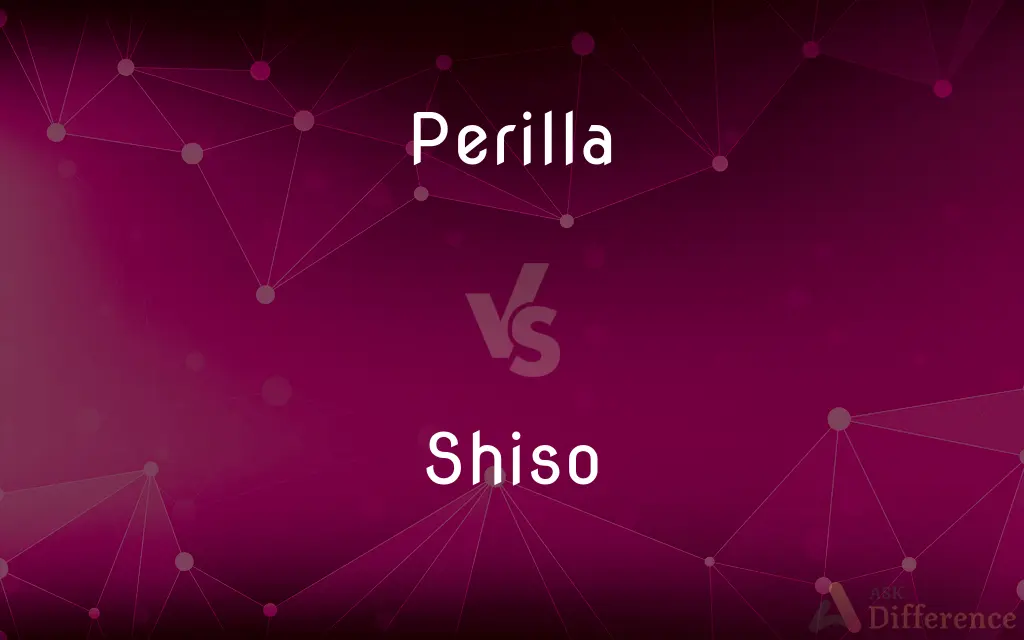Perilla vs. Shiso — What's the Difference?
Edited by Tayyaba Rehman — By Urooj Arif — Updated on April 7, 2024
Perilla refers to genus of annual herbs in mint family, with varieties used in cuisines & for ornamental purposes. Shiso, key variety of Perilla frutescens, is specifically used in Japanese cuisine for its distinctive flavor & decorative appeal in dishes.

Difference Between Perilla and Shiso
Table of Contents
ADVERTISEMENT
Key Differences
Perilla encompasses a broad genus of plants within the mint family, Lamiaceae, known for their aromatic leaves and seeds used in cooking, medicine, and as ornamentals. Shiso, on the other hand, refers specifically to the leaves of Perilla frutescens var. crispa, a variety prized in Japanese cuisine for its unique flavor profile that adds a fresh, herby, and somewhat minty taste to dishes.
While Perilla as a genus has a wider application, including the use of its oil-rich seeds for culinary and industrial purposes, shiso's usage is predominantly culinary, especially within Japanese and Korean cuisines, where it is also known as kkaennip. The distinction between Perilla and shiso is crucial for understanding the plant's versatility and the specific cultural contexts in which it is used. In Korean cuisine, the term "perilla" often refers to the larger leaves of Perilla frutescens used for wrapping food, which differ in flavor and texture from the smaller, more delicate shiso leaves used in Japanese dishes.
Cultivation practices for Perilla vary widely, as the plant adapts to different climates and soil types, showcasing its versatility. Shiso, however, requires specific conditions to develop its characteristic flavor, often cultivated in well-drained soil with partial shade. This specificity in cultivation reflects shiso's unique standing within the Perilla genus, emphasizing its distinct use and cultural significance in Japanese cuisine.
Both Perilla and shiso offer a variety of health benefits, including anti-inflammatory and antioxidant properties, thanks to their rich composition of phenolic compounds. However, the culinary focus on shiso, particularly in Japanese cuisine, highlights its role not just as a food ingredient but as a cultural emblem, embodying the aesthetics and flavors of traditional Japanese cooking.
Comparison Chart
Definition
A genus of annual herbs in the mint family.
A variety of Perilla frutescens used in Japanese cuisine.
ADVERTISEMENT
Use
Culinary, medicinal, ornamental, and industrial.
Predominantly culinary, especially in Japanese dishes.
Varieties
Multiple, including Perilla frutescens.
Perilla frutescens var. crispa, specific to shiso.
Flavor Profile
Varies among species; generally aromatic.
Fresh, herby, and somewhat minty.
Culinary Application
Seeds and leaves used in various cuisines.
Leaves used as garnish, in salads, sushi, etc.
Cultural Significance
Broad, varying by region and species.
Highly significant in Japanese (and Korean) cuisine.
Compare with Definitions
Perilla
Known for its seeds used in oil production and cooking.
Perilla seed oil is a staple in Korean cooking for its nutty flavor.
Shiso
Used predominantly in Japanese and Korean cuisines.
Shiso is essential in many traditional Japanese dishes for its flavor and decorative appeal.
Perilla
Used medicinally in some cultures for its health benefits.
Perilla leaves are used in traditional medicine to treat various ailments.
Shiso
Specific variety of Perilla frutescens known for its culinary use in Japan.
Shiso leaves are a common garnish in Japanese sushi.
Perilla
Cultivated worldwide for different purposes.
Perilla plants are grown as ornamentals for their attractive foliage.
Shiso
Represents a cultural emblem in Japanese cuisine.
Shiso symbolizes the elegance and subtlety of Japanese culinary traditions.
Perilla
A genus of annual herbs in the mint family with diverse culinary and ornamental uses.
The farmer cultivated Perilla for both its aromatic leaves and seeds.
Shiso
Cultivated for its leaves, rather than seeds.
Green and red shiso leaves are cultivated for their distinct tastes and uses in cooking.
Perilla
Varied in species, each with unique characteristics.
The Perilla frutescens variety is popular for its edible leaves and seeds.
Shiso
Characterized by its unique flavor and aroma.
The fresh, minty taste of shiso enhances the flavor of salads and tofu dishes.
Perilla
Perilla is a genus consisting of one major Asiatic crop species Perilla frutescens and a few wild species in nature belonging to the mint family, Lamiaceae. The genus encompasses several distinct varieties of Asian herb, seed, and vegetable crop, including P. frutescens (deulkkae) and P. frutescens var.
Shiso
Perilla frutescens var. crispa, also known by its Japanese name shiso, is a cultigen of Perilla frutescens, a herb in the mint family Lamiaceae.
Perilla
An annual ornamental Asian plant (Perilla frutescens) in the mint family, having large green or purple-red leaves, small white flowers, and oil-yielding seeds. Also called beefsteak plant.
Shiso
A plant of the mint family, native to eastern Asia, used as a herb in Japanese cooking.
Perilla
The aromatic leaves of this plant, used as a condiment and flavoring in East Asian cuisine. In both senses also called shiso.
Shiso
See perilla.
Perilla
An East Asian herb with flavorful leaves used in cooking and as a garnish, Perilla frutescens. Also grown for the seeds, which contain an edible and industrially-useful oil.
Shiso
Any of several varieties of the herb Perilla frutescens, related to basil and mint, used in Japanese cooking.
Perilla
A genus of labiate herbs, of which one species (Perilla ocimoides, or Perilla Nankinensis) is often cultivated for its purple or variegated foliage.
Perilla
Small genus of Asiatic herbs
Common Curiosities
Can Shiso leaves be used for medicinal purposes?
Yes, like other Perilla varieties, shiso leaves possess anti-inflammatory and antioxidant properties beneficial for health.
How does the flavor of Shiso compare to other herbs?
Shiso offers a unique, fresh, and somewhat minty flavor, distinct from other herbs, making it a favorite in Japanese cuisine for its ability to complement a wide range of dishes.
Are Perilla seeds and Shiso leaves interchangeable in recipes?
No, they serve different culinary purposes. Perilla seeds are often used for their oil or as a spice, while shiso leaves are used fresh as a garnish or ingredient.
What dishes are Shiso leaves commonly used in?
Shiso leaves are used in sushi, salads, as garnishes for tofu and meat dishes, and in drinks for their aromatic flavor.
Is there a difference in cultivation between Perilla and Shiso?
Shiso requires specific conditions to develop its characteristic flavor, while Perilla, in general, is more adaptable to different environments.
Why is Shiso particularly important in Japanese cuisine?
Its unique flavor and decorative appeal make it indispensable in many traditional dishes, symbolizing Japanese culinary aesthetics.
Do Perilla and Shiso have any health risks?
Both are generally safe for culinary use, though individuals with specific plant allergies should proceed with caution.
What is the main difference between Perilla and Shiso?
Perilla refers to a broader genus of plants with various uses, while shiso specifically denotes a variety used mainly in Japanese cuisine for its unique flavor.
Is Shiso only used in Japanese cuisine?
While shiso is most closely associated with Japanese cuisine, it is also used in Korean cuisine and is gaining popularity in various international dishes for its unique flavor.
Can I grow Shiso at home?
Yes, with the right conditions—well-drained soil and partial shade—shiso can be grown in home gardens.
Share Your Discovery

Previous Comparison
Studying vs. Reading
Next Comparison
Apomixis vs. ParthenocarpyAuthor Spotlight
Written by
Urooj ArifUrooj is a skilled content writer at Ask Difference, known for her exceptional ability to simplify complex topics into engaging and informative content. With a passion for research and a flair for clear, concise writing, she consistently delivers articles that resonate with our diverse audience.
Edited by
Tayyaba RehmanTayyaba Rehman is a distinguished writer, currently serving as a primary contributor to askdifference.com. As a researcher in semantics and etymology, Tayyaba's passion for the complexity of languages and their distinctions has found a perfect home on the platform. Tayyaba delves into the intricacies of language, distinguishing between commonly confused words and phrases, thereby providing clarity for readers worldwide.














































